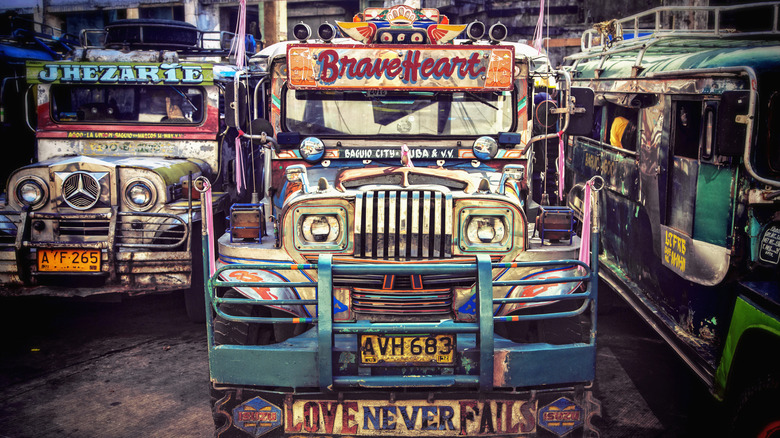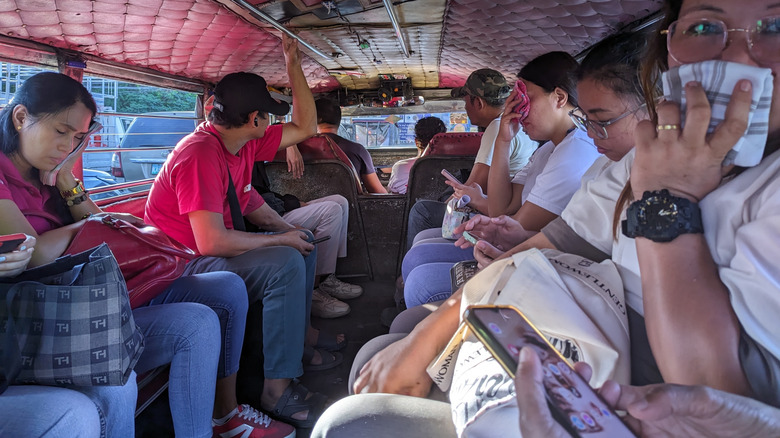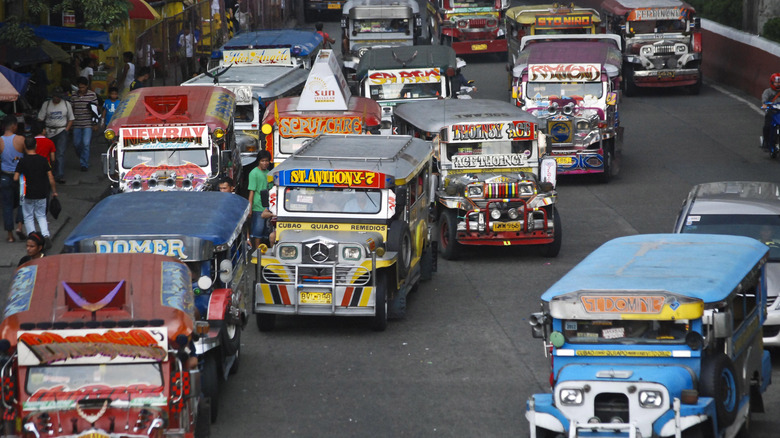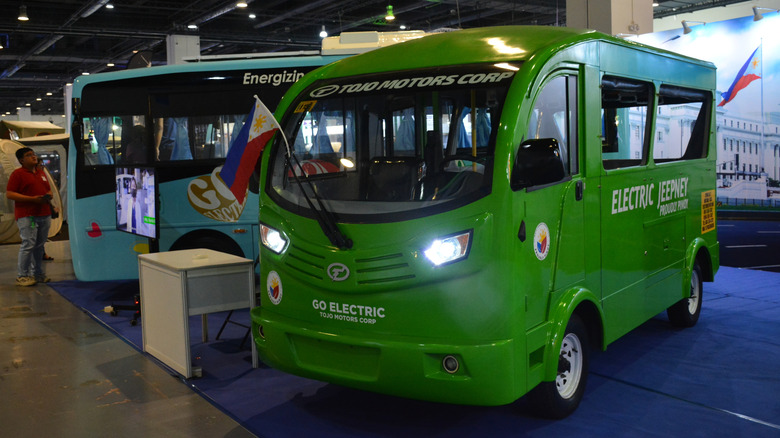What Are Jeepneys? How The Philippines' Public Transport Icon Was Created
The different modes of mass transportation used by cities and countries around the world are as diverse and colorful as the people they're made to move. Japan has high-speed bullet trains. New York City uses Yellow Cabs, while England has red double-decker buses, the Underground, and their famous black hackney carriages (taxi cabs). Gondolas rule Venice, San Francisco uses cable cars, and Thailand has its tuk-tuks. But in the streets that crisscross the Philippines, the "King of the Road" is the pervasive Jeepney.
As the name suggests, a Jeep is involved in the fabrication of these wildly personal and creative conveyances that have become as synonymous with the Filipino culture as the tasty Lumpia. The United States military operated from a number of bases in the Southeast Asian country during World War II. As is typical during a war, the fighting subsequently ravaged the land, particularly the streets and cable cars in Manilla.
Once the war was over, these well-supplied bases chock full of equipment — including vast quantities of Willys Jeeps – began to shutter, and the military started selling off the oddly named Jeeps for as little as $200 each. Needing a new way to move people and supplies around the country, industrious Filipinos bought them in bulk and began to resurrect the city's transportation infrastructure. Mechanics began converting the veritable endless supply into mass transit vehicles capable of going anywhere and called them jeepneys, a combination of the words "Jeep" and "jitney," a term used to describe a vehicle used to carry passengers cheaply.
Get in, hold on, and touch knees
Creators of the Jeepney took the standard military Jeep and elongated it by using sheets of galvanized stainless steel. Then they slapped a roof on top, but instead of using expensive glass windows, they left the sides open and covered them with curtains. When all was said and done, the once stubby Jeep had been turned into a bus capable of carrying more than 20 passengers. Another tale about the "jeepney" name comes from everyone being so tightly packed that their knees hit each other.
The concept spread like wildfire across the archipelago of more than 7,000 islands, with each owner/operator turning their jeepneys into individualized rolling works of art bedazzled with loud stickers, splashed with bright murals, and capped with chrome bumpers, wheels, and hood ornaments of all kinds. Some, like the "karatig" jeepneys driven in the City of Malolos in the province of Bulacan, are smaller than usual and only carry 10 to 15 passengers. Ultimately, no two look the same.
These funky machines are typically powered by old engines, usually very basic refurbished 3.3-liter four-cylinder diesels from Isuzu (which does not make Ford's Duramax despite the myth) without any high-tech features like turbochargers or electronic fuel injection systems. Most don't even have an exhaust system. These archaic workhorses are sturdy and cheap to maintain but are incredibly loud, hard to get into, and send egregious amounts of exhaust fumes into the air. When combined with the haphazard and constant stop/starting of taking on and letting off passengers, they're a primary source of traffic congestion.
Jeepneys as far as the eye can see
Despite the many shortcomings, jeepneys have become an integral part of the culture. In 2009, a song called "Jeepney Love Story" was released by Josephine "Yeng" Eusebio Constantino-Asuncion (regarded as Pop Rock Royalty in the Philippines), about finding love in unexpected places — like a jeepney. Stores sell models, pictures, and toys made from beer cans of the colorful buses. Filipinos love karaoke so much that it's become the national pastime, so it's not uncommon to find karaoke machines aboard with passengers singing at the top of their lungs, and a "Jeepney King" contest is held each year in Manilla to award the most beautiful bus.
According to CNN Travel, approximately 200,000 jeepneys are zipping around Philippine roads, which makes up nearly 40% of the country's transportation needs (equating to 40 million person-trips daily). Another source claims at least 240,000 exist, with 55,000 of those in Metro Manila alone.
Most are privately owned and run by a sole proprietor. For decades, they've been a vital means of affordable transportation for students and low-income workers because even today it only costs 20 cents (13 Philippine pesos) to ride. In a country where the average annual income is, according to the International Monetary Fund, roughly $4,400 — the cheaper, the better.
However, all that culture and individuality appears to be coming to an end. In 2017, the transport ministry issued a public utility vehicle modernization program (PUVMP) with the goal of updating the country's public transit system by replacing the jeepney — really, any vehicle over 15 years old — with newer imported minibusses.
Riding off into the sunset
To remain in business, each proprietor had to merge with at least 15 other owners to form a transport corporation (or cooperative). As one might expect, this was met with outrage by the public, who openly protested in mass against the change and has since dragged out the change for years.
The Philippine Land Transportation Franchising and Regulatory Board (LTFRB) issued an ultimatum to operators on February 27, 2023, that extended that deadline to June 30. When almost 100,000 drivers and operators threatened to stage a nationwide transport strike, the LTFRB extended the deadline to December 31, 2023.
The change to more modern buses that all look the same eradicates the individuality jeepneys are known for. Still, it allows for more passengers (and more room for those passengers), provides modern amenities like air-conditioning, and runs on much cleaner fuel, which would greatly help reduce domestic greenhouse gas emissions because they account for 94% of the urban soot in Metro Manila.
All that modernization comes at a hefty cost, which many jeepney operators can't afford. A modern bus costs around $50,000 ($2.8 million Philippine pesos), whereas a traditional jeepney costs between $4,900 and $15,000 (200,000 – 600,000 Philippine pesos). According to official data (as reported by CNN), as of January 2024, approximately 76% of jeepney owners have consolidated, and over 1,700 cooperatives have formed per program regulations, numbers jeepney operators and activists dispute.



